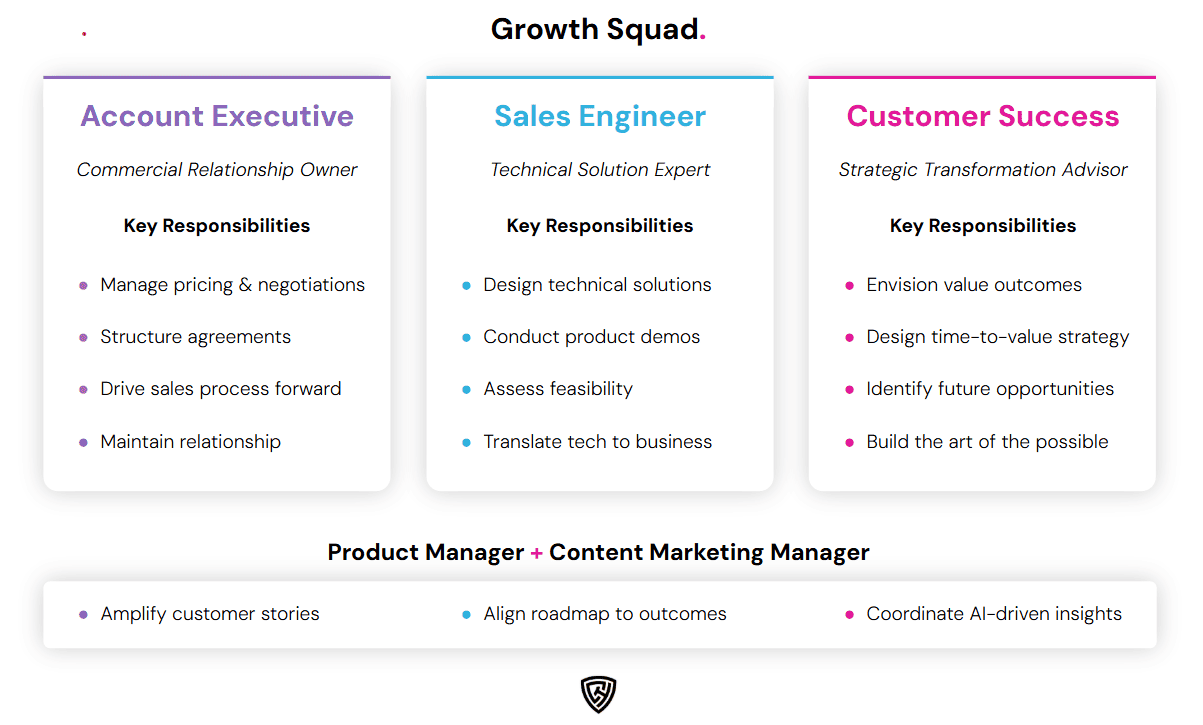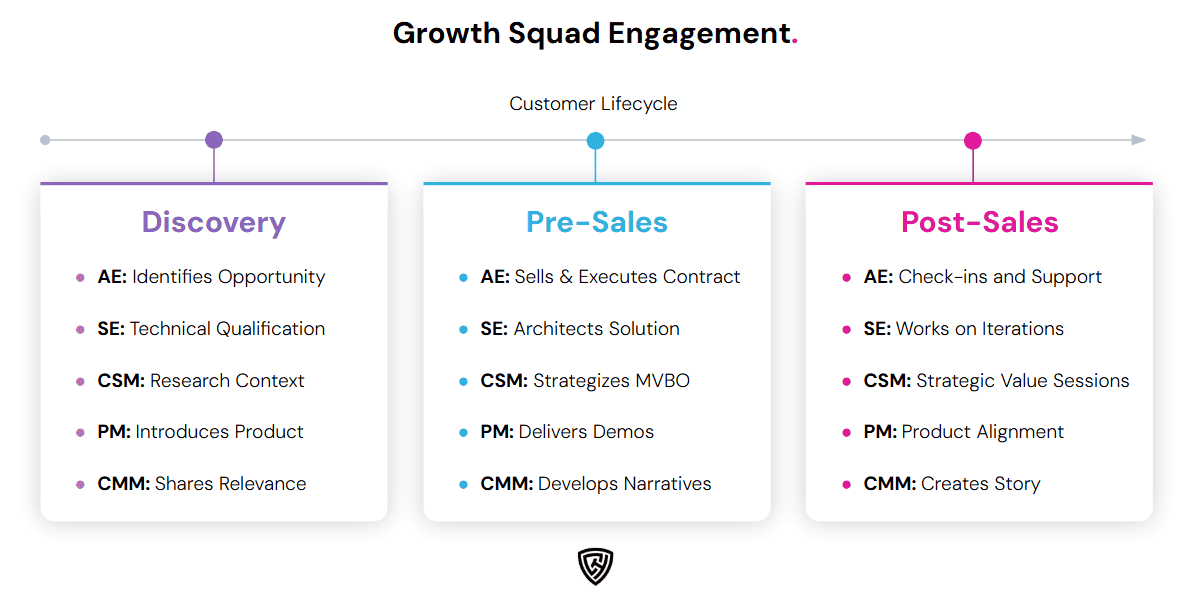Growth Squads: How Cross-Functional Teams Drive Customer Value
Why the future of Customer Success is about strategic orchestration across the entire customer lifecycle.
Customer Success has an identity crisis.
CSMs are asked to be everything: strategist, technical expert, salesperson, project manager, product specialist, and relationship owner. The result? They become generalists who never achieve excellence in any single area. Meanwhile, customers experience disjointed handoffs, misaligned expectations, and fragmented relationships with multiple stakeholders who never quite seem to be on the same page.
The solution isn’t to make CSMs superhuman. It’s about fundamentally rethinking how we structure customer-facing teams.
This isn’t a new concept for me. I discussed the concept previously after an interesting discovery call I had 6 years ago, a concept I expanded on, and then further introduced CS as part of pre-sales.
And additional reading can be found here.
Growth Squads
A Growth Squad is a small, cross-functional team that works together throughout a customer’s lifecycle to generate value and drive growth for the organization continuously. Unlike traditional models where customers are passed from sales to implementation to success like a relay baton, Growth Squads maintain continuity from discovery through expansion.
This isn’t about sales. It’s about strategic orchestration of growth, for your customer first, and your organization second.

The Core Partnership Model
The most effective Growth Squads operate with clear role definitions that prevent overlap and build accountability:
Account Executive (AE)
- Owns: Sales, finance, legal, contracts
- Focus: The business mechanics of the relationship
Sales Engineer (SE)
- Owns: Technical implementation, demos, architecture, development
- Focus: Technical delivery and product functionality
Customer Success Manager (CSM)
- Owns: Strategy, art of the possible, voice of customer, time to value, strategic value alignment
- Focus: The strategic orchestration of customer value and outcomes
For smaller organizations, the core duo of CSM + AE can be effective, with the CSM taking on more technical responsibility.
The Extended Squad: Amplifying Growth
To truly unlock growth potential, add two critical roles:
Product Manager (PM)
- Owns: Roadmap alignment, product demonstrations, and processing customer requests
- Focus: Ensuring product-customer strategic alignment
Content Marketing Manager (CMM)
- Owns: Customer stories, content relevance, voice of customer, thought leadership
- Focus: Accelerating and amplifying success through narrative
This structure prevents the chaos that comes from poorly defined boundaries. When CSMs are forced to take on everything, they never deliver excellence. With the Growth Squad model, each member operates at their highest value.
When Does the Squad Engage?
Always. Starting at pre-sales.
This is the fundamental shift: CSMs are no longer solely post-sales. By bringing them forward, you eliminate messy handoffs, accelerate onboarding, and ensure alignment from day one.

Discovery Phase (All focused on alignment)
- AE: Identifies opportunity
- SE: Asks initial technical questions
- CSM: Researches industry context and competitive landscape
- PM: Introduces product capabilities
- CMM: Shares relevant examples, validation, and credibility
Pre-Sales Phase (All focused on growth)
- AE: Sells and executes contracts
- SE: Architects solutions
- CSM: Strategizes MVBO and accelerates onboarding (which begins now)
- PM: Delivers demos and plans implementation
- CMM: Shares customer stories and listens for future narratives
Post-Sales Phase (All focused on what’s next)
- AE: Checks in and supports expansion
- SE: Works with services, works on next iteration
- CSM: Facilitates Strategic Value Sessions
- PM: Maintains product alignment
- CMM: Integrates the customer into the content ecosystem
Notice the shift: post-sales isn’t about metrics and backwards-looking reporting. It’s about a future-focused strategic partnership.
Key Strategic Elements
1. Parallel Onboarding
Within this configuration, onboarding begins during the pre-sales motion. Provide free accounts, dedicated demo environments, and start identifying the Minimal Viable Business Outcome (MVBO) immediately. The goal: get customers using the product, finding immense value, and becoming so embedded that they don’t want to leave.
Primary metric: Time to Value
2. MVBO (Minimal Viable Business Outcome)
Customers often focus on big picture transformations. MVBO brings them down to the smallest possible outcome that delivers the most value in the shortest time. It’s discovering the one outcome that, if solved, gets you a “yes” and immediately vests them in your product.
This becomes the North Star for the entire Growth Squad during pre-sales and initial implementation.
3. Strategic Value Sessions (SVS)
Replace backwards-facing QBRs with forward-facing Strategic Value Sessions. These are collaborative, outcome-focused engagements with your customer’s executive team designed to generate immediate business value.
Strategic Value Sessions:
- Secure C-suite participation and a seat at the strategic table
- Identify the next MVBO achievable in 30-60 days
- Co-create strategic roadmaps through whiteboarding and collaborative problem-solving
- Build momentum through rapid value delivery
- Embed your company into the customer’s long-term strategic plans
- Include the entire Growth Squad, plus customer executive leadership
The goal is to build your customer’s growth roadmap instead of focusing on metrics. In doing so, the direct result is your growth.
4. Product Participation
So many problems are resolved when the Product participates in the process. Stop selling what you don’t have. Start co-creating products around what customers want.
Including Product Managers in Growth Squads creates a closer relationship between the voice of the customer and your product roadmap. Then align your product roadmap with your customers’ future roadmaps. Symbiotic growth.
5. Marketing Participation
Here’s a common scenario: A new prospect asks about a use case, and marketing has no success stories to demonstrate it. Why? Because marketing is typically 6 months behind a deal closing, then they produce a case study sometime after that.
The Growth Squad approach: Begin developing the customer story during the pre-sales motion. Capture critical moments in parallel. Present them in batches.
Beyond case studies, integrate customers into your content strategy. At Google, I created an entire podcast (That Digital Show) specifically for Customer Success, bringing customers in to discuss their work. It also allowed CSMs to become thought leaders.
Here’s why this matters: I once wrote an article about Cloud implementation at Banks. I attended a pre-sales meeting with my Growth Squad for a new Bank prospect. The AE had shared my thought leadership article in advance. When I walked into the executives’ room, my article was up on the screen. Someone joked about hiding it before I arrived. It showed me something profound: I had credibility about the topic before I even walked in the door.
The rest of the meeting was hugely successful. They asked me detailed questions, and we used the article as a reference instead of slides. This happened because, in my CSM capacity, I aligned with marketing to develop specific content for our team.
What This Is and Isn’t
This is not:
- About making CSMs responsible for retention and renewals alone
- About outdated metrics like logo retention or NPS
- About AI replacing human relationships
- About sales quotas and commission structures
This is:
- Strategic orchestration of growth for customers first, organization second
- Deep and meaningful focus on being present in the right way at all stages
- Creating continuity and eliminating friction in the customer experience
- Customer Value Alignment (CVA) is the guiding principle
The Shift Required
Moving to a Growth Squad model requires organizational courage. It means:
- Breaking down departmental silos
- Redefining success metrics to focus on customer outcomes
- Trusting cross-functional teams with customer relationships
- Investing in pre-sales CS resources
- Aligning compensation structures to team success, not individual quotas
But the payoff is transformative: faster time-to-value, higher retention, greater expansion, and customers who view you not as a vendor but as an embedded strategic partner.
Customer Value Alignment
At its core, the Growth Squad model is about Customer Value Alignment (CVA), ensuring that everything your organization does is orchestrated to deliver value to your customers. When you align your entire go-to-market motion around this principle, growth becomes the natural outcome rather than a forced objective.
Your customer’s success becomes your success. Their growth roadmap becomes intertwined with yours. And the Growth Squad becomes the strategic engine that makes it all possible.
The question isn’t whether Growth Squads work. The question is: can you afford to keep operating with the fragmented, handoff-heavy model that’s failing customers today?